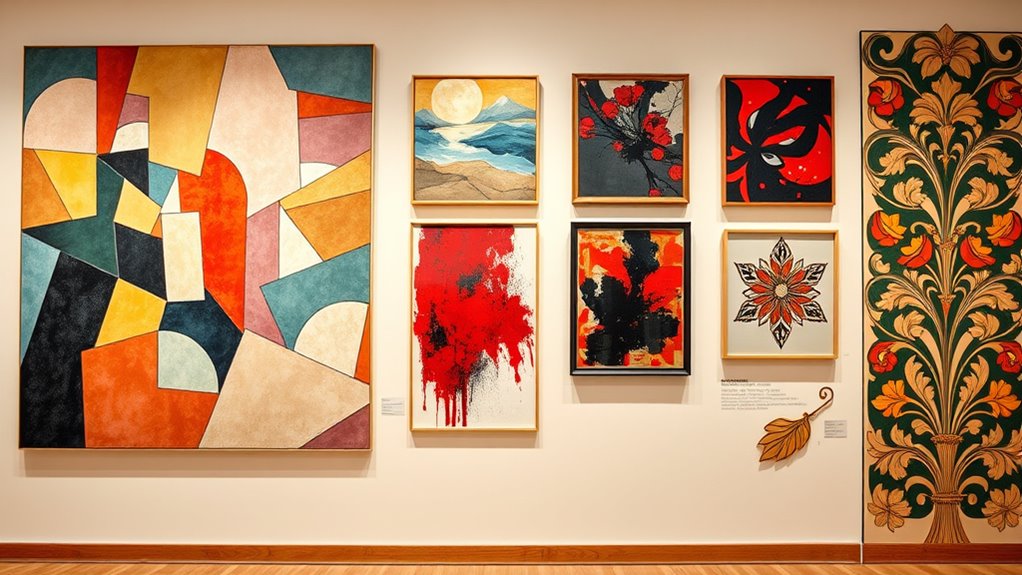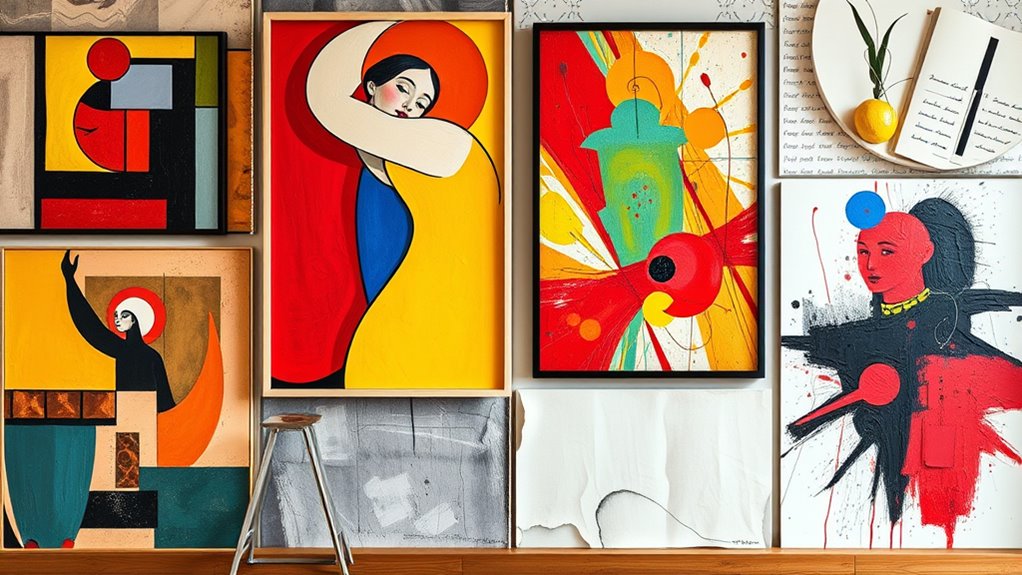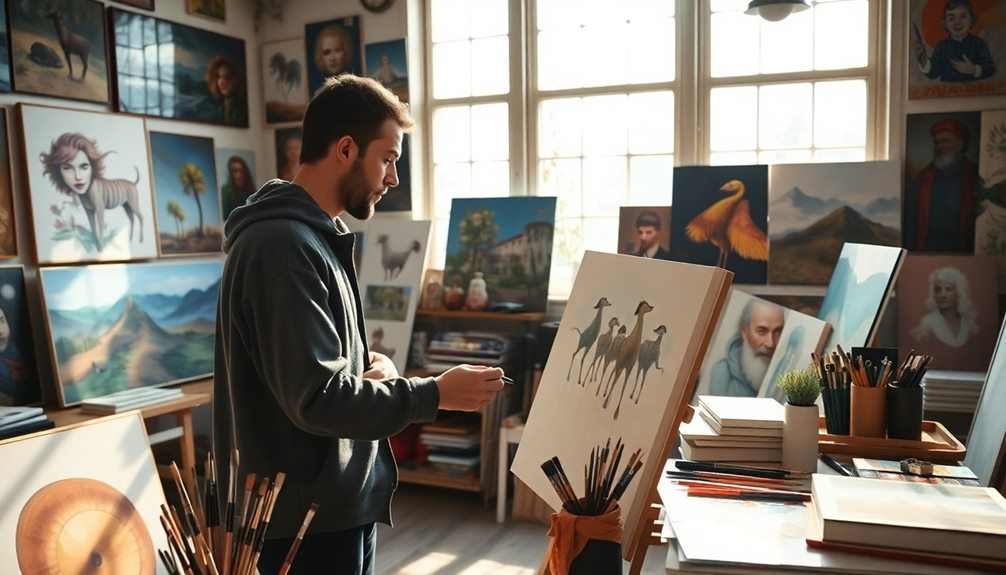Major art movements are shaped by societal, cultural, and technological changes. For example, Impressionism in 19th-century France captured fleeting moments and the effects of light, while Modernism in the early 20th century embraced abstraction and emotional expression amid societal upheaval. Key artists like Monet, Picasso, and Matisse led these styles, pushing boundaries. Understanding the roots of these movements shows how art reflects human ideas and history. Keep exploring, and you’ll discover how each movement tells its unique story.
Key Takeaways
- Art movements reflect societal changes and are driven by groups of artists sharing similar ideas.
- Impressionism emerged in late 19th-century France, focusing on light, color, and capturing modern life.
- Modernism arose in the early 20th century, emphasizing abstraction, innovation, and emotional expression.
- Key artists like Monet, Picasso, and Matisse pioneered styles that challenged traditional norms.
- Art serves as a mirror of society’s technological, political, and cultural transformations throughout history.

Have you ever wondered how art has evolved over time to reflect changing societies and ideas? It’s fascinating to see how different art movements originated as responses to cultural shifts, technological advancements, and political events. These movements often emerge from groups of artists who share similar ideas about how art should look or what it should express. By understanding the origins of these art movements and the famous artists involved, you gain insight into the broader historical context that shaped each style.
Take the roots of Impressionism, for example. It began in France in the late 19th century, as artists sought to break away from traditional academic standards. These artists, like Claude Monet and Pierre-Auguste Renoir, aimed to capture fleeting moments and the effects of light and color. The origins of this movement stemmed from a desire to depict modern life more spontaneously and authentically, challenging the realism that preceded it. The movement’s rebellious spirit was fueled by new technological developments in paint and canvas, allowing artists to experiment more freely. As you explore famous Impressionist works, you’ll notice how their quick brushstrokes and vibrant palette embody their desire to portray the world in a fresh, immediate way. Recognizing how technological innovations influenced art can deepen your appreciation for these stylistic shifts.
Impressionism emerged in France to capture fleeting moments with vibrant colors and spontaneous brushwork.
Similarly, the origins of Modernism trace back to the late 19th and early 20th centuries, driven by rapid industrialization and societal upheaval. Artists like Pablo Picasso and Henri Matisse sought to break away from traditional perspective and realistic depictions, instead emphasizing abstraction and emotional expression. Modernist art was born out of a need to reflect the complexities of the modern age—technology, urbanization, and changing social norms. Understanding the cultural climate that fostered these innovations helps to contextualize their revolutionary approaches and the motivations behind their experimentation. These shifts were also influenced by advances in artistic techniques, which allowed for new methods of expression and experimentation. You can see its influence across many styles, from Cubism to Surrealism, all rooted in a desire to challenge conventions and explore new ways of seeing the world.
Understanding the origins of art movements also reveals how they connect with the famous artists who pioneered them. Each movement’s birth is often linked to key figures who pushed boundaries and redefined artistic norms. For example, the Fauvist movement, characterized by bold colors and wild brushwork, was driven by artists like Matisse and André Derain, who wanted to express raw emotion and individual vision. Knowing their backgrounds and the cultural climate of their time helps you appreciate their innovations and the movement’s significance. Additionally, the social and political contexts of these artists’ lives often inspired their bold choices and thematic content.
In essence, exploring the origins of art movements and the influential artists behind them lets you see how art reflects the society it emerges from. Whether it’s the rebellious spirit of Impressionism or the experimental nature of Modernism, these styles are more than just visual choices—they’re responses to the world’s ongoing story. By understanding their roots, you can better appreciate the dynamic evolution of art and its power to mirror human ideas and societal shifts.
Frequently Asked Questions
How Do Art Movements Influence Modern Contemporary Art?
Art movements shape modern contemporary art by fueling artistic evolution and inspiring new ideas. You see historical styles influence current artists’ choices, techniques, and themes, leading to contemporary reflections that blend tradition with innovation. This ongoing dialogue between past and present pushes creativity forward, ensuring that today’s art remains dynamic and relevant. By understanding these movements, you gain insight into how artists continually adapt and reinterpret artistic legacies in their work.
What Are the Key Differences Between Abstract and Non-Abstract Art?
When comparing abstract vs non-abstract art, you see a clear art style differentiation. Abstract art emphasizes shapes, colors, and forms without representing real objects, focusing on emotion and concept. Non-abstract, or figurative art, depicts recognizable subjects like people or landscapes. You’ll notice abstract art often feels more expressive and open to interpretation, while non-abstract provides a direct, realistic depiction, making each style unique in conveying meaning.
How Can I Identify Different Art Styles in a Painting?
To identify different art styles in a painting, look at the color palettes and brushstroke techniques. Bright, bold colors and expressive strokes might point to Impressionism, while precise, detailed work could indicate Realism. Abstract art often uses unconventional colors and shapes, and thick, textured brushstrokes. Pay attention to how the artist uses color and brushwork to evoke mood or style, helping you distinguish between various artistic movements.
Are There Any Lesser-Known Art Movements Worth Exploring?
Imagine discovering hidden art in a small gallery, revealing fringe movements you’ve never heard of. Some lesser-known art movements, like Suprematism or Tachisme, are worth exploring because they challenge traditional styles and push creative boundaries. These hidden art forms often fly under the radar but offer fresh perspectives and unique techniques that can inspire your appreciation for diverse artistic expressions. plunge into these fringe movements—you might find your new favorite style.
How Do Cultural and Political Contexts Shape Art Movements?
You see that cultural and political contexts greatly shape art movements through social influences and political upheavals. When society faces change or turmoil, artists respond by reflecting, criticizing, or inspiring action. These moments push artists to challenge norms or express collective emotions, creating new styles. Your understanding of art’s evolution reveals how external events directly influence artistic themes, techniques, and movements, making art a mirror of societal shifts and political climates.
Conclusion
So, now you’re an art history expert—ready to impress at parties or just confuse your friends. Remember, these art movements weren’t just about pretty pictures; they were bold statements, rebellions, and revolutions wrapped in paint and sculpture. But don’t get too comfortable—next time you see a “modern masterpiece,” ask yourself: is it genius or just someone’s attempt to look profound? Either way, you’re now officially a connoisseur. Or at least, you look like one.









